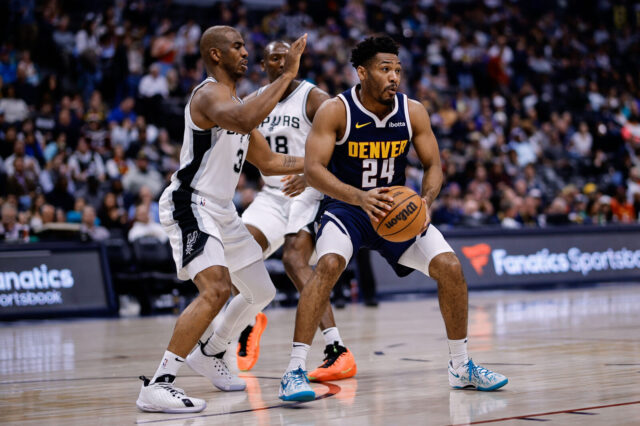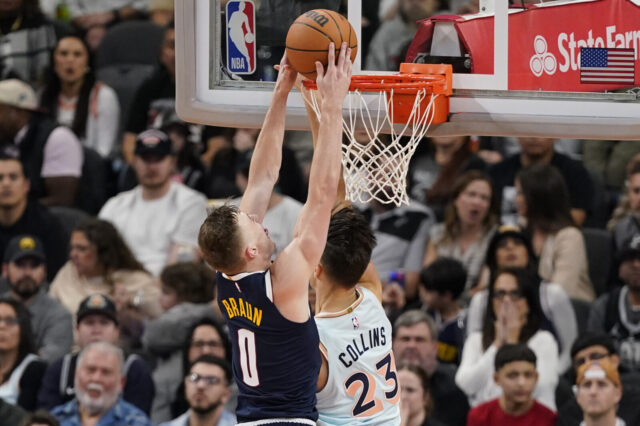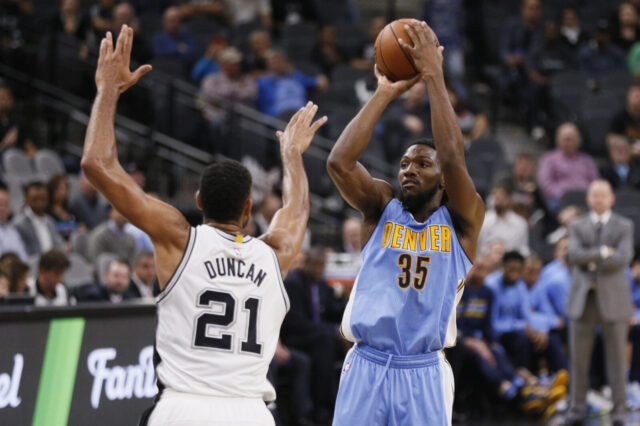To the ESPN Trade Machine!
Kyrie Irving’s request to be traded from the Cleveland Cavaliers has put the NBA world on notice, and frankly, it couldn’t come at a better time for the Denver Nuggets. The bulk of the free agency period has ended, and the Nuggets got their guy in free agency already, Paul Millsap. They don’t have to feel the pressure to make a power play in the Western Conference because they already acquired a top player in the NBA, though at the expense of Danilo Gallinari.
Right now, the Nuggets are all but guaranteed to use a starting lineup on Opening Night of the 2017-18 season that features Millsap, Nikola Jokic, Wilson Chandler, and Gary Harris. Four of the slots are set in stone, while the fifth, point guard, is not. There were opportunities to trade for or sign a point guard in free agency, but so far, Tim Connelly and Arturas Karnisovas have remained quiet outside of signing Millsap and accepting a 2019 second round pick in a three-way Gallo trade. It doesn’t mean that the Nuggets aren’t seeking out point guard upgrades though. They have been rumored to be interested in Eric Bledsoe, George Hill, Chris Paul, and Kyle Lowry, though with much less steam on the latter two.
Irving is another matter entirely. The point guard is just entering his prime, having turned 25 years old last March. He’s one of the most talented offensive players in the league with room still to grow, and he’s just entering the prime of his career. The listed guards are all in their thirties except Bledsoe, yet he has also dealt with injury issues and still has some wear and tear. Irving has also dealt with injuries during his career, but he’s played in more than 70 games in three of the last four years of his career, which none of the above players can say.
There’s also a matter of what Irving does on the court, because he’s not a perfect player by any means. The defensive concerns are very real, and the WAY he scores doesn’t necessarily line up with how the Nuggets play best as a team; however, if there’s one thing he does really well, it’s create opportunities to score for himself. No player can match his abilities in the isolation game statistically, and he’s among the elite in terms of creating for himself out of the pick and roll. Both isolations and pick and rolls remain poor plays in terms of value added during the first 42 minutes of games, but they help during the last six minutes of games when the defense locks in.
Irving’s true shooting percentage in the clutch is 54.4%. It is a step below the likes of LeBron James, Isaiah Thomas, Jimmy Butler, and Stephen Curry, but it would rank second to only Nikola Jokic on the Nuggets roster currently. Having a dribble creator is infinitely more valuable than a post up creator during the clutch as well. Among all players to maintain a usage rate of 25% or greater in clutch situations last year, only five were big men: DeMarcus Cousins, Anthony Davis, the newly acquired Paul Millsap, Blake Griffin, and Nikola Vucevic. For the latter two, it didn’t go well either. The rest of the players with high usage were guards and wings, as they naturally have an easier time getting a shot off than a big man, which usually involves a pass into the post or out of the pick and roll.
The Nuggets as a team performed terribly in clutch situations last year. They had the 25th ranked offensive rating with less than five minutes to go and both teams within five points of each other. Reduce that to December 15th onward, and they performed more adequately at 13th overall, but it does nothing when the defense is ranked 25th as well, creating a Net Rating of -9.0 in clutch situations.
I, more than most people, understand that Irving is a fundamentally flawed player. While most of the general public views Irving as a top 5 point guard, my statistical ranking placed him 12th, below the likes of Jeff Teague, Jrue Holiday, and Bledsoe. Even still, the position is incredibly top heavy, falling off the map at about the 17th ranked point guard. As a team, you either have one or you don’t, and the Nuggets definitely do not have one. Jamal Murray is intriguing as a prospect, but asking a 20-year-old to be a leader of the team is almost as desperate as asking a 19-year-old to be the leader, something the Nuggets are all too familiar with regarding Emmanuel Mudiay.
Here is a brief statistical comparison of Irving in his first season and Murray during the second half of the past season, when he played predominantly backup and starting point guard:
| Player | Usage % | True Shooting % | Assist % | AST/TO Ratio |
|---|---|---|---|---|
| Kyrie Irving | 28.7 | 56.6 | 36.5 | 1.72 |
| Jamal Murray | 22.3 | 53.0 | 15.9 | 1.80 |
It really is surprising to hear so many Denver fans saying they believe that Jamal Murray will be the better point guard than Kyrie Irving in one season, two seasons, or sometime in the future. It very well might happen, but so far, there is little statistical evidence to support it.
With that in mind, let’s jump into some fake trade ideas.
Trade #1: The Cavaliers begin their rebuild with two young guards
This content is no longer available.
*A 2018 lottery protected first round pick from Denver would also be included.
This scenario focuses on the Cavaliers choosing the mentality of long term development. Currently, Cedi Osman is the youngest player on the Cavs roster, a draft-and-stash player from the 2015 draft finally brought over. The Cavs need an influx of young talent, especially if LeBron James walks away for nothing next summer. Kenneth Faried represents matching salary, but the real pieces going to the Cavs are Murray, Malik Beasley, and an extra first round pick. Cleveland may ask for more from Denver, but Denver should be firm on the quantity and quality of young prospects that they are willing to give up in these scenarios.
For the Nuggets, Irving fills in at the point guard position, the rest of the starting five remains untouched, and while Murray and Faried are big losses to the rotation, the Nuggets have a number of forwards ready to assume Faried’s minutes with little drop off in talent, specifically Juancho Hernangomez and Trey Lyles.
Trade #2: The Cavaliers try and stay competitive
This content is no longer available.
*A 2018 lottery protected first round pick from Denver would also be included.
It’s quite possible though that the Cavs would like to remain competitive during the last year of LeBron’s contract, so as to keep the peace between the organization and their best player who’s also 32 years old. The Nuggets have a number of pieces ready to contribute now, from starting caliber guards to wings to power forwards. In this scenario, Denver sends back Gary Harris, who would nearly supplant Osman as the youngest player on the team, as well as Wilson Chandler and Jameer Nelson. The Cavs would possess a variety of options for their starting lineup talent wise, and they could even use Harris as the point guard defender while continuing to give James playmaking duties. Chandler and Nelson represent great bench depth, or at least better than anything the Cavs currently possess, while Harris is inserted into the starting lineup in Irving’s place.
For the Nuggets, this scenario is tough to swallow for a variety of reasons. Denver loses two wing players, and if Denver has a major weakness right now, it’s their wing depth. The starting lineup would likely feature Irving, Murray, Hernangomez, Paul Millsap, and Nikola Jokic, which still features great talent but likely poor defense. Iman Shumpert could be inserted, but how much is that really going to help matters? Still, Denver retains what they think to be their top two prospects in Jokic and Murray, and they add Irving, a player who Murray would do well to learn some moves from for at least the next two seasons.
Trade #3: Rope in some assets from Phoenix
This content is no longer available.
*A 2018 unprotected first round pick would be sent from Denver to Phoenix
**This deal would be predicated on Phoenix agreeing to terms with Mason Plumlee beforehand
There are a lot of major moving parts here, but let me start with Cleveland. Instead of getting back Jameer Nelson as their starting point guard, they receive Eric Bledsoe. Bledsoe is a great talent at the point guard position as well, and he would help the Cavs remain competitive. They also receive Hernangomez and Will Barton from Denver, both of which are ready to contribute off the bench and assist in different ways. This is good value for Irving at this point, and it wouldn’t surprise me if Cleveland said yes to this deal.
For Phoenix, it’s a little more tricky, but there are a variety of reasons for them to like the move. On one hand, they move Bledsoe for assets, something that is long overdue. The Suns and Nuggets were rumored to be discussing a Bledsoe deal at the draft, and going back to the Suns would have been Mudiay and a late lottery pick. In this deal, same basic terms apply, though the pick would no longer be in the lottery in all likelihood. Instead, the Suns get out of Tyson Chandler’s contract and free up playing time for Plumlee as their new starting center. He would assist as a playmaker for Mudiay, Devin Booker, Josh Jackson, Marquese Chriss, and Dragan Bender, helping facilitate good offense with those young pieces. They get back Kenneth Faried’s deal, and also Jameer Nelson if they desire, both of which would be good veterans to have during a rebuild or buyout candidates in Nelson’s case.
For Denver, they send out six players and only get two in return, but the players that truly matter still remain. The starting lineup is untouched, both Harris and Murray are kept by Denver to form a three-guard rotation with Irving, and Tyson Chandler slides in as the backup center for Nikola Jokic, a good contrast of skill sets. Again, the depth on the wing would be questionable, as young players like Malik Beasley, Tyler Lydon, and even Trey Lyles may have to spend some time in the rotation. Still, those holes could eventually be remedied in future moves (like this one).
Trade #4: Let’s send Melo to Cleveland instead
This content is no longer available.
If any of the fantasy trades are actually possible, this one is by far my favorite.
The premise of the deal is that Carmelo Anthony goes to join LeBron in Cleveland as the third scorer in the starting lineup, which becomes a little wonky with those two and Kevin Love, but it would still be interesting. Either the Cavs could complete that trio with Tristan Thompson and a guard, or they could use two guards and send Thompson to the bench. Or, they could get really weird and send one of Melo or Love to the bench to be a super sixth man type. The Cavs also get back Jameer Nelson, Will Barton, and Emmanuel Mudiay, a variety of guards to mix and match with the forwards the Cavs already possess. It’s weird and extremely unlikely, but fun to think about from a position-less basketball perspective.
For the Knicks, they get out of Melo’s contract and move him with Lance Thomas. They get back Faried, a New Jersey native and immediate fan favorite, as well as Iman Shumpert and Juancho Hernangomez. The idea of pairing Willy and Juancho together surrounding Kristaps Porzingis has to be incredibly enticing. Getting back any young prospects at all would be great for New York, but to get back an excellent shooter and rebounder in Juancho would be great value for Anthony. Throw in Shumpert as a defensive wing returning to New York, and the Knicks look all the better in this deal.
For Denver, the deal is similar to the last one, with Irving coming and both Murray and Harris staying in the Mile High City. This time though, Denver gets a viable backup at small forward in Lance Thomas. Thomas is by no means an elite backup, but he’s a veteran who can space the floor (shot 38/85 from the 3-point line last season) and at least provide some resistance defensively. The loss of three players in the backcourt will be felt, but a three guard rotation of Irving, Murray, and Harris should excite a lot of people.
Trade #5: Get the other team from New York instead
This content is no longer available.
This trade is likely more comparable value for Irving than either of the last two moves, and by roping the Brooklyn Net into the deal, it becomes more viable for the Cavs.
Cleveland would receive three guards in return for Irving and Shumpert, two of which will help them immediately (Jeremy Lin and Will Barton) and one of which will help them later (Murray). With James running the show in Cleveland, Lin playing point guard becomes a great secondary creator for others. Lin averaged 14.5 points, 5.1 assists and 3.8 rebounds in just 36 games for the Nets last year while shooting 37.2% from the 3-point line. His true shooting percentage of 56.6% was nearly equivalent to Irving’s, and his assist rate of 35.5% actually surpassed Irving. Lin was incredibly underrated as the point guard for the Nets last year, and adding him and Barton should keep the Cavs at the top of the food chain in the Eastern Conference this year. Murray gives them a chance to remain there for years to come.
For the Nets, the dichotomy of trading for a great guard prospect in D’Angelo Russell means he will need time to develop as the focal point of the offense in Brooklyn. With Lin in town, it’s possible that Russell doesn’t get enough touches to develop the way he needs to, and there’s also Caris LeVert, Sean Kilpatrick, Spencer Dinwiddie, and Isaiah Whitehead to consider behind Lin and Russell. In place of Lin and Rondae Hollis-Jefferson, the Nets receive Faried, still a New Jersey native, along with two young prospects in Emmanuel Mudiay and Trey Lyles. Mudiay would instantly become the guard with the second highest ceiling on the Nets, and the storylines of both he and Russell playing together after forming possibly the worst and shortest rivalry in NBA history would be pretty funny. Add in Lyles, who would instantly be the best front court prospect on the team, and the Nets are still sitting pretty in their rebuild.
For Denver, Murray and Mudiay are both sacrificed in this deal, but Irving is obviously the prize of the return, and Denver actually gets some playable wing depth to compensate. Both Shumpert and Hollis-Jefferson would be very helpful. Hollis-Jefferson in particular would make for an excellent contrast to Hernangomez, who would slide to his rightful spot as a backup power forward. Nelson sticks around as the backup point guard, but this leaves an opportunity for both Beasley and the newly signed Monte Morris to fight for playing time as the fifth guard behind Irving, Harris, Nelson, and Shumpert. The starting lineup remains untouched, and while young pieces are sacrificed, the Nuggets still have Jokic, Harris, Hollis-Jefferson, Hernangomez, Beasley, and Lydon as players age 22-and-under. It’s not like they lose their future.
Overall, you have to give something to get something in the NBA. Very rarely do teams have an opportunity to acquire a star at the age of 25, and the right to acquire said player will surely cost something. Recent history of stars being traded shows that teams acquiring stars don’t have to empty the entire war chest of assets:
- DeMarcus Cousins was acquired for Buddy Hield, Tyreke Evans, Langston Galloway, a first rounder and a second rounder.
- Jimmy Butler was acquired for Zach LaVine, Kris Dunn, and the right to move from the 16th pick to the 7th pick in this year’s draft.
- Paul George was acquired for Victor Oladipo and Domantas Sabonis. Lol.
The price tag of one mid-to-high level asset, another mid level asset, and possibly something extra has been set by these three trades. It may not take a Jamal Murray or Gary Harris to get things done, but Denver would have to accept that just sending back Emmanuel Mudiay and picks isn’t going to get it done either. Including a third team’s assets is likely the best way to get things done without losing Murray or Harris, and the prospect of Irving, Harris, and Murray in the backcourt together would be exciting to say the least.
The trade is not likely to happen, but if it did, let Denver Stiffs know your thoughts about trade possibilities in the comments section, on Facebook, or on Twitter.
This content is no longer available.


